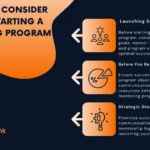
Not every mentoring program is set up for success. Many mentoring programs begin with great intentions but fail due to poor structure, lack of support, or mismatched pairs. Mentorship should feel like a journey of growth, not a forced obligation. If mentoring program red flags go unnoticed, these programs can quickly become a drain on resources rather than a meaningful path for development. For program admins and HR departments, that is the worst-case scenario because when mentoring relationships go south, they can lower engagement and job satisfaction even more than if participants had never joined at all. Nobody wants to be stuck in an unhealthy relationship, especially not at work. That’s why it is crucial to recognize what a healthy mentoring relationship looks like, spot the red flags in a mentoring program early, and understand the signs that a program might be doing more harm than good.
What are Main Mentoring Program Red Flags?
Mentoring programs, like any structured development initiative, carry risks when not thoughtfully designed and consistently managed. Red flags in mentorship programs appear when the structure prioritizes formality over substance or when inclusivity and alignment are ignored.
Lack of Support in Workplace
A mentoring program cannot thrive without broad organizational support. One of the most glaring mentoring program red flags is when leadership merely endorses mentoring as a buzzword without committing resources, time, or attention to its success. If managers fail to adjust workloads so participants can engage fully, or if there is no recognition for mentors who invest time in guiding others, the program quickly loses momentum.
Lack of support often shows up in subtle ways. For instance, mentors may not receive training on how to structure sessions, or mentees might not have access to resources like learning materials or dedicated spaces for discussion. In some organizations, mentoring becomes a low-priority activity that employees squeeze into already packed schedules, making interactions rushed and unproductive. Without real support, the program becomes symbolic rather than impactful, signaling to participants that development is not truly valued. In order to increase attendance and interest in your mentoring program you can start thinking about how to announce your mentoring program.
Inaccurate Audience
A strong and well-organized mentoring program depends on matching the right people. When the audience is misidentified or mismatched, frustration follows. A common red flag is when participants are randomly paired without consideration for goals, expertise, or compatibility. For example, a junior employee seeking guidance in leadership skills may be paired with a mentor whose experience is primarily technical, leaving little overlap in goals.
Another sign of audience inaccuracy is when organizations use mentoring as a blanket solution without assessing whether participants are ready or interested. Some employees may not be open to mentoring relationships at all, while others might seek coaching or training instead. If the program fails to account for different readiness levels or ignores the actual needs of its participants, it risks disengagement and wasted energy.
A mentoring program should not just fill slots but it should foster purposeful connections. When the audience is misunderstood, even the most well-intentioned structure will struggle to produce meaningful outcomes.
Poor User Experience
Mentoring is not merely about pairing people; it is about the experience. Mentorship programs often fail when user experience is overlooked. Complicated platforms, unclear scheduling, or vague goals frustrate participants. When progress tracking feels like red tape, interest fades.
The culture matters too. If openness is discouraged, mentees will not share honestly, and mentors may hold back. A rigid checklist-driven program feels transactional, stripping away the essence of real mentoring. Warning signs include frequent cancellations, surface-level talks, and a sense that it’s about checking a box rather than true growth. A mentorship program design can be so effective to promote your mentoring program. Our blog content “How to Design a Mentoring Program?” can give you clues about roadmap of launching mentoring program.
Absence of Clear Mentorship Goals
Another significant red flag is the absence of defined goals. Mentoring without direction often devolves into casual conversations that may feel pleasant but achieve little. When neither the mentor nor the mentee understands the purpose, whether it’s career development, skill-building, or leadership preparation, sessions lack focus.
Without setting goals, it becomes difficult to measure success, and both parties may question whether the relationship is worth their time. Over time, the program risks being perceived as a nice idea with no tangible benefits.
One-Sided Relationships In Mentorship Program
Mentoring should be a two-way exchange, where both mentor and mentee feel they are gaining something valuable. A red flag arises when the relationship becomes one-sided. This can happen if a mentor treats the program as a chore, offering little energy or engagement. On the other hand, some mentees may approach mentoring passively, expecting their mentor to do all the work while they remain disengaged.
A one-sided dynamic erodes trust and leaves one party feeling drained. In some cases, mentors may feel exploited if their contributions are not acknowledged, or mentees may feel neglected if mentors are inconsistent. Over time, such dynamics damage the credibility of the program.
Lack of Evaluation and Feedback
Another serious mentoring program red flag is the absence of evaluation mechanisms. Mentoring programs that never ask participants for feedback or fail to monitor outcomes are unlikely to improve. Without evaluation, leadership cannot identify whether goals are being met or whether participants feel satisfied. This absence creates a cycle where the same problems repeat in every iteration of the program, ultimately leading to stagnation or abandonment.
How to Avoid Pitfalls of Mentoring Program Red Flags
Spotting mentorship program red flags early means you can fix them before a mentoring program falls apart.
Leadership support matters most: A mentoring program thrives when leaders champion it by providing resources, promoting it openly, and recognizing participants. When employees see leadership backing it, they can take it seriously.
Exact matching is key: Do not rush the mentor-mentee pairing. Take time to understand mentees’ goals and mentors’ strengths. You can use surveys, interest assessments, or short intro sessions before finalizing matches.
Make mentoring program experience simple and engaging: A user-friendly mentoring platform, clear communication, and timely reminders help participants stay involved. Offering guides, checklists, or quick training sessions makes the process smoother for everyone.
Set clear goals and accountability: Define the program’s purpose from the start, whether it’s building leadership, onboarding new hires, or encouraging cross-team collaboration. Regular check-ins and progress tracking keep people accountable and moving forward.


